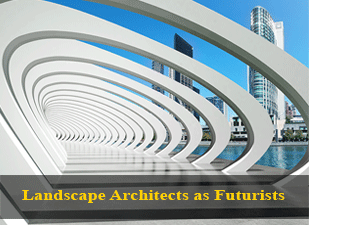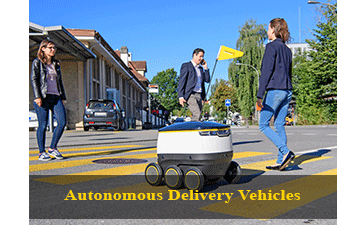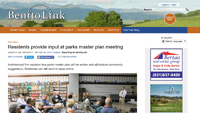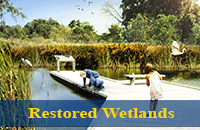Landscape Architects as Futurists
Author: Alison Kelly, Landscape Designer, ASLA
 The way we learn about the profession of landscape architecture and its practice tends to be a study of context. Technical courses teach students to see physical characteristics of a site. We learn to identify slope, follow the point of steepest grade in a trail of mud following a rainstorm, and identify the plants and ecosystems that define a site. Theoretical courses teach students to see the intangible qualities of a site; history, usage patterns, and the implications of design decisions upon users and usability. We learn about node, edge, and the exciting but unpredictable possibilities of how a site may develop or come to be used in a way different from that which we originally intended.
The way we learn about the profession of landscape architecture and its practice tends to be a study of context. Technical courses teach students to see physical characteristics of a site. We learn to identify slope, follow the point of steepest grade in a trail of mud following a rainstorm, and identify the plants and ecosystems that define a site. Theoretical courses teach students to see the intangible qualities of a site; history, usage patterns, and the implications of design decisions upon users and usability. We learn about node, edge, and the exciting but unpredictable possibilities of how a site may develop or come to be used in a way different from that which we originally intended.
Even forward-thinking landscape architecture practice usually involves a re-combination of this basic approach to the physical and intangible characteristics of a site. Excellent work regarding waterfront and post-industrial redevelopment work has inspired a generation of landscape architects. "What can this become?" is the question that sets most of us on fire. We imagine a behemoth dump as a park, breathing life back into a great metropolis. A concrete drainage channel of Hollywood lore transforms into a living waterway, mixed-use development and microbreweries springing up like eddies along its length. Disused utility easements become oases for habitat in the most unexpected of urban places.
These are developments which propose interventions to improve the future conditions of the place. We have also seen an increasing amount of "futuristic" landscapes, which adhere to a variety of theories and definitions. The latter tend to involve current high-tech features such as interactive light or water features, app-enabled components, and more. But what of the not-so-glamorous nuts and bolts of people evolving towards reality enhancing technology? We may have anticipated autonomous vehicles for some time (to little effect in our design decisions), but what of the myriad possibilities of autonomous delivery vehicles, of the average urban dweller navigating his or her day with the aid of a reality enhancing headset, or the convenience/intrusion of biometric scanning as an ApplePay-inspired method of negotiating daily life?
Without the human element, landscape architecture is not landscape architecture. Yet humans do not remain static, and are now in the process of a great time of technology-assisted development. In light of these impending realities, what can landscape architects do to maintain an edge on the design of public spaces? It is, I think, a question we must ask.
As a profession of such varied talents and individual specialties, there is a place for landscape architects as futurists. There exist landscape architects as ecologists, landscape architects as living systems designers, landscape architects as food system engineers, landscape architects as health care amenity designers. Leafing through the ASLA annual meeting presentations is enough to inspire the most dispirited of practitioners with the possibilities that may be and have been.
One who is a "futurist" is, as defined by the Association of Professional Futurists (APF), "a person who studies the future in order to help people understand, anticipate, prepare for and gain advantage from coming changes." There is a certain resonance in this for landscape architects. Whether we study the condition of a breakwater and local weather patterns in order to recommend an appropriate intervention, or recommend a green roof or living system at an urban development project to address the urban heat island effect, we are in essence studying current conditions and predicting future trends in order to help people prepare for and gain advantage from coming changes.
 Recently in the news, a string of articles caught my eye. First, from an article on CNBC.com, April 21st, 2017: "Robots are Now Delivering Food in San Francisco." Next, on Eater.com, May 17th, 2017: "San Francisco Declares War on Food Delivery Robots." Also from May 17th, 2017, this time on technology blog Wired.com: "San Francisco Tries to Ban Delivery Robots Before they Flatten Someone's Toes."
Recently in the news, a string of articles caught my eye. First, from an article on CNBC.com, April 21st, 2017: "Robots are Now Delivering Food in San Francisco." Next, on Eater.com, May 17th, 2017: "San Francisco Declares War on Food Delivery Robots." Also from May 17th, 2017, this time on technology blog Wired.com: "San Francisco Tries to Ban Delivery Robots Before they Flatten Someone's Toes."
The first article reports the San Francisco robots in question are run by a company called Marble, founded to rethink the "last mile" of the delivery supply chain. Meant as a step toward relieving vehicular and courier snarls during the final stage of delivery of small packages and items, the article goes on to reference companies such as Amazon, Alphabet, and Uber which have also been investing in this facet of the supply chain.
The articles,following initial rollout of the automated delivery system, indicate the sort of offended backlash which follows an unanticipated offense. The Eater.com article pegs the issue as one of insufficient policy paired with infrastructure. It quotes San Francisco City Supervisor Norman Yee as noting, "Our streets and our sidewalks are made for people, not robots. This is consistent with how we operate in the city, where we don't allow bikes or skateboards on sidewalks." The article reports that when asked if he thought robots could safely run in a bike lane, Yee agreed it was something to think about; "Maybe in the future there will be robot lanes." The article goes on to report progress in urban policy integrating "last mile" delivery robots across the United States and internationally. It does, however, note that the robot companies themselves often lead planning and policy initiatives, which can lead to a narrow definition of a municipality's approved specifications that apply exclusively to that company's product.
These articles - and their rapid succession - stood out to me as strange for a few reasons. First, given the city's location adjacent to Silicon Valley, San Francisco residents and managers should not be unprepared for the introduction of automated systems to perform mundane tasks. Starwood Aloft hotels have been using a mobile automated system to deliver sundry items such as toiletries to hotel guests since 2014. Silicon Valley company Knightscope manufactures security robots which have been roaming buildings and industrial complexes in the Bay Area for at least a year prior to deployment of Marble's food delivery robots.
Second, as a dense West Coast megacity with notoriously progressive urban development policies, it is surprising that San Francisco is resisting the benefits of a potentially advantageous technological advancement. Delivery robots, especially when automated to follow given paths and arrive at specific locations (very possible using satellite mapping technology), represent a potential solution to a number of traffic headaches. The narrow streets of historic cities are often clogged by delivery trucks, a trend which is on the rise. Millennials in particular, continue to invest in the convenience of home delivered groceries, meal plans, clothing sampling services, and Amazon Prime for everything else. This human behavioral pattern has consequences for the health and function of our cities and the policy and design response must adjust itself dynamically to accommodate such trends.
It is common in conversations with landscape architects and planners to arrive at mutual agreement about the antiquarian views of traffic congestion and the cyclical solution of simply adding more lanes for vehicular traffic. Many praise the benefits of multi-modal transportation planning, of transit-oriented development, and of a robust non-motorized transportation system to create healthier cities and invest in strategies proven through historical applications. We must ask, however, if these views are quickly becoming as antiquarian as the automotive focused interventions we disparage. Do we not have technology which can work, now, complementing evolving human behavior, to produce a healthier system?
The landscape architect as futurist may be any of us of different professional specialties. We are, at heart, a profession made up of practitioners who study variations of environmental context and human influence. We have the opportunity now to look to the future in order to help people understand, anticipate, prepare for, and gain advantage from coming changes. Our lifetimes will see dynamic shifts in the way humans coevolve with technology. It is time for landscape architects to look creatively upon these changes, and ask with a futurist's eye: what can this become?
To learn more about related issues and other landscape architecture topics, please visit the publications section of our website by clicking here.
 The way we learn about the profession of landscape architecture and its practice tends to be a study of context. Technical courses teach students to see physical characteristics of a site. We learn to identify slope, follow the point of steepest grade in a trail of mud following a rainstorm, and identify the plants and ecosystems that define a site. Theoretical courses teach students to see the intangible qualities of a site; history, usage patterns, and the implications of design decisions upon users and usability. We learn about node, edge, and the exciting but unpredictable possibilities of how a site may develop or come to be used in a way different from that which we originally intended.
The way we learn about the profession of landscape architecture and its practice tends to be a study of context. Technical courses teach students to see physical characteristics of a site. We learn to identify slope, follow the point of steepest grade in a trail of mud following a rainstorm, and identify the plants and ecosystems that define a site. Theoretical courses teach students to see the intangible qualities of a site; history, usage patterns, and the implications of design decisions upon users and usability. We learn about node, edge, and the exciting but unpredictable possibilities of how a site may develop or come to be used in a way different from that which we originally intended.
 Recently in the news, a string of articles caught my eye. First, from an article on CNBC.com, April 21st, 2017: "Robots are Now Delivering Food in San Francisco." Next, on Eater.com, May 17th, 2017: "San Francisco Declares War on Food Delivery Robots." Also from May 17th, 2017, this time on technology blog Wired.com: "San Francisco Tries to Ban Delivery Robots Before they Flatten Someone's Toes."
Recently in the news, a string of articles caught my eye. First, from an article on CNBC.com, April 21st, 2017: "Robots are Now Delivering Food in San Francisco." Next, on Eater.com, May 17th, 2017: "San Francisco Declares War on Food Delivery Robots." Also from May 17th, 2017, this time on technology blog Wired.com: "San Francisco Tries to Ban Delivery Robots Before they Flatten Someone's Toes." 

